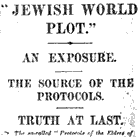 |
 |
What are "The Protocols
of the Elders of Zion"?
The war that the Nazis waged against the Jews was not just a war of physical annihilation. It was an international war of propaganda to convince the rest of the world of the evils of Judaism. One of the primary weapons that the Third Reich used for this international effort was a forgery known as "The Protocols of the Elders of Zion." It is claimed that the Protocols are the minutes of a meeting of Jewish leaders at the first Zionist Congress in Basel, Switzerland, in 1897, in which Jews plotted to take over the world. The Protocols are a complete forgery most of which was copied from an obscure satire on Napoleon III by Maurice Joly called "Dialogue aux Enfers entre Montesquieu et Machiavel" ("A Dialogue in Hell Between Montesquieu and Machiavelli").
The story of the Protocols starts with a chapter in a novel called "Biarritz" by a German bureaucrat named Hermann Goedesche writing under the pseudonym "Sir John Retcliffe" (sometimes altered to "Sir John Readcliffe" in later literature). Goedesche was an anti-Semite in the middle of the 19th century who believed in a conspiracy between Jews and Masons to dominate the world. One chapter of the novel, titled "In the Jewish Cemetery in Prague" relates a speech by a Rabbi named Eichhorn or Reichhorn which reveals a Jewish plot against European civilization. Although it was part of a novel, it was printed separately as an anti-Semitic pamphlet in Russia as early as 1872. It was widely circulated as a truthful account for the rest of the 19th century and represents the precursor of the Protocols. It is still occasionally attached to current editions of the Protocols.
The Protocols were actually written in Paris sometime between 1895 and 1899 by an agent of the Russian secret police Pytor Ivanovich Rachovsky, who is known to have forged other documents for the various intrigues in which he took part. While the Protocols are overtly anti-Semitic it is believed that the Russian minister of finance, Sergei Witte, was also a target of the Protocols. At the time Witte was the leader of the movement to modernize Russia and limit the influence of the old Russian aristocracy. The Protocols attempt to discredit Witte's reforms of the Russian economy by linking Witte's program to a Jewish plot to destroy western civilization.
The Protocols, as they are usually published, are divided into twenty-six separate chapters each of which are a lecture on how to subvert western civilization, although some versions, including the first in Englsh, did not have this division. The "program" set forth in the Protocols is vague and generalized. The Protocols advise, for example: "Therefore in governing the world the best results are obtained by violence and intimidation, and not by academic discussions." (Protocol 1). Some are just silly. One Protocol (23) advocates making people unhappy by passing laws prohibiting drunkenness. The Protocols are vigorously anti-democratic as well. Protocol 25 advises: "Several members of the seed of David will prepare Kings and their successors, who will be elected not by right of inheritance but by their own capabilities. These successors will be initiated in our secret political mysteries and plans of governing, taking great care that no one else should acquire them."
The parochial political controversies that sparked the writing of the Protocols was soon forgotten but the anti-Semitism remained. The Protocols were first published in full by Sergei Nilus, another agent of the Russian secret police, in 1905. Nilus, who might have been one of the authors of the Protocols, became their main promoter; he circulated several editions of the Protocols in Russia as part of an campaign of anti-Semitism. While the early publications of the Protocols were in Russia, it was spread to the rest of Europe by Russian expatriates after the fall of the Tsars in 1917, where they claimed that it provided proof that the Jews were behind the Russian Revolution. Another expatriate Russian, Boris Brasol, brought it to the United States around 1920 where it became the core of Henry Ford's anti-Semitic program. By the time Nilus died in 1930, Europe had been saturated by millions of copies of the Protocols. It had also been exposed as a forgery.
